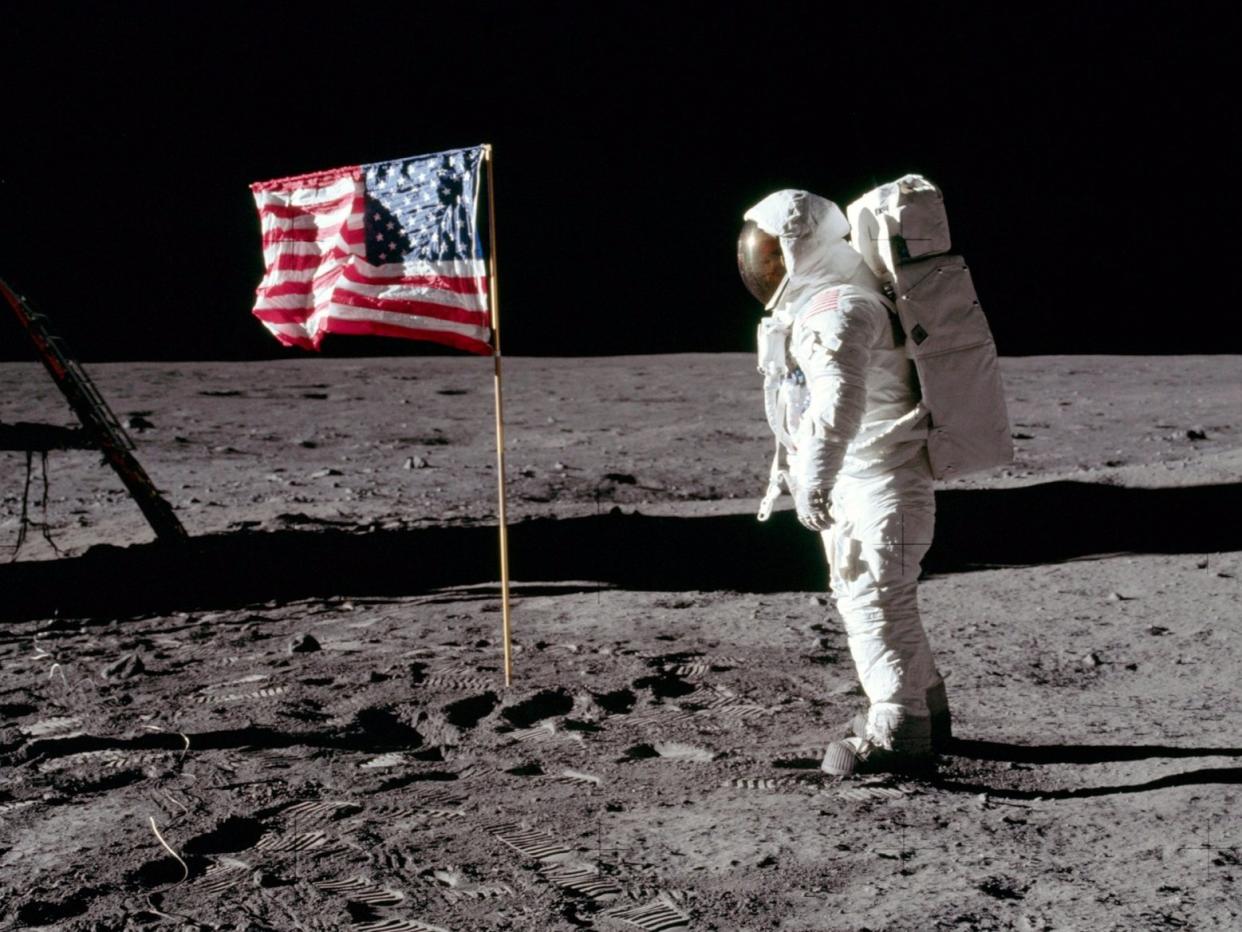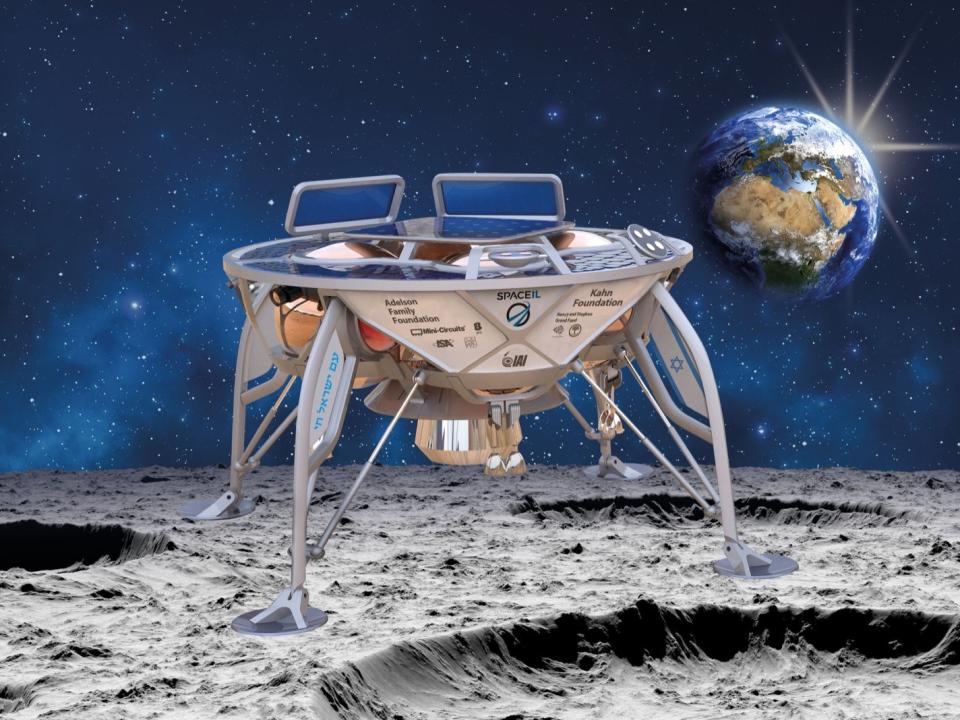The American flags on the moon are disintegrating

NASA
Astronauts on each of NASA's six Apollo missions planted an American flag on the moon.
Powerful sunlight and a lack of atmosphere to filter it have likely bleached all of the Apollo flags white.
As NASA celebrates its 60th anniversary on Monday, it's possible some of the flags are also disintegrating.
The photos have stood the test of time: A spacesuit-clad Apollo astronaut stands proudly next to a red-white-and-blue American flag on the moon, his national trophy telling the lonely world, "the United States was here."
Unfortunately, all six flags planted from 1969 through 1972 haven't fared so well. Images taken by NASA's Lunar Reconnaissance Orbiter in 2012 do show that at least five out six flags still stand. However, scientists think decades' worth of brilliant sunlight have bleached out their emblematic colors.
The result? The flags are probably completely bone-white by now, as we first learned from Gizmodo.
But their condition may now be even worse than that as NASA celebrates its 60th birthday on October 1: Some of the flags are likely starting to disintegrate.
Each one of the flags was made by the company Annin Flagmakers, woven out of rayon, and cost NASA $5.50 (more than $32.00 when adjusted for inflation). On the surface of Earth, such flags fade in sunlight. That's because ultraviolet light — the same wavelength that causes sunburn — isn't fully absorbed by our planet's atmosphere, and it excels at breaking down fibers and colors.
The moon doesn't have any atmosphere to absorb sunlight, and outside of craters there is no shade. This means the flags planted by the Apollo astronauts are exposed to constant, gleaming sunlight and even more solar radiation, and for two-week stretches at a time. (One "day" on the moon lasts about 28 Earth days.)
Writing in a July 2011 article for Smithsonian Air & Space magazine, lunar scientist Paul Spudis explains:
"Over the course of the Apollo program, our astronauts deployed six American flags on the Moon. For forty-odd years, the flags have been exposed to the full fury of the Moon's environment – alternating 14 days of searing sunlight and 100° C heat with 14 days of numbing-cold -150° C darkness. But even more damaging is the intense ultraviolet (UV) radiation from the pure unfiltered sunlight on the cloth (modal) from which the Apollo flags were made. Even on Earth, the colors of a cloth flag flown in bright sunlight for many years will eventually fade and need to be replaced. So it is likely that these symbols of American achievement have been rendered blank, bleached white by the UV radiation of unfiltered sunlight on the lunar surface. Some of them may even have begun to physically disintegrate under the intense flux.
"America is left with no discernible space program while the Moon above us no longer flies a visible U.S. flag. How ironic."
Will we return to the moon?

SpaceX
Much has changed — and a lot hasn't — since Spudis' lament.
No person has returned to the moon.
However, NASA is working hard to fly astronauts into deep space by developing its ultra-powerful Space Launch System rockets. The goal is to build a "gateway" that'd reach lunar orbit around 2026, according to NASA's latest plans.
The lunar space station could be then filled with astronauts. From there, the astronauts could control lunar landers and robots (perhaps to scout for water deposits that could be mined and turned into rocket fuel) and eventually use the facility as a way point to send people to and from the surface.
The commercial sector is also working on grand plans to reach the moon.
Tech mogul Elon Musk and his aerospace company, SpaceX, are building a giant carbon-fiber spacecraft called Big Falcon Rocket that should be capable of reaching the moon or Mars. By 2023, Musk plans to launch the company's first space tourist — a Japanese billionaire named Yusaku Maezawa — in one of the spaceships, along with a crew of hand-picked artists. The plan is to fly them around (but not land on) the moon.
Amazon founder Jeff Bezos, who owns the rocket company Blue Origin, is eager to move industry into space and colonize the moon.

SpaceILYet prior to these larger companies reaching the moon or landing any people there, smaller outfits like SpaceIL may land a robot on the surface as soon as 2019. They would not only deliver small private payloads, but also broadcast high-definition footage of their adventures back to Earth.
Other companies with similar robotic plans may try to land near the site of Apollo 11, 12, 14, 15, 16, or 17 and record live views of the historic sites as they look today.
If that comes to pass, there may be an iconic flag in the frame — and we might settle the question of what they actually look like after spending more than 45 years under the sun.
Jennifer Welsh contributed reporting to a previous version of this article.
This story has been updated with new information. It was originally published on April 9, 2017.
NOW WATCH: SpaceX will use this capsule to slingshot two civilians around the moon
See Also:

 Yahoo News
Yahoo News 

